#we are as perennial as the grass
Text

EDITED TO ADD: Sources from the OP in the comments
#trans#nonbinary#trans nonbinary#ancient history#sumer#gender#we have always been here#historical trans people#you cannot legislate us away and you cannot wipe us out while humanity still exists#we are as perennial as the grass#inanna#trans is sacred
26K notes
·
View notes
Text
Oh, God, it's so important to learn to NOTICE though. When I first started learning about plants I realized that the real world—the REAL real world, and that's what I'm getting at here really, the natural world is so much more REAL, because human made environments are like...very dim, simplified simulations—is boggling to the mind in its sheer level of detail.
It feels like there's so much happening on the screen when you look at the internet, so much visual chaos in the form of ads and sidebars and videos that play automatically, but, God, just look at some dirt. Look at a regular patch of grass and weeds and look at how much there is going on.
How many species of plant are in a weedy, overgrown lawn? Whatever number you guess, it's too low, because you haven't learned to see. You can only see big and obvious shapes and colors. But I realized I was trapped in this...almost toddler-like simplification in my perception, and I realized that the more I cracked my brain open trying to identify plants and trees, the more I could zoom in on the parts of nature that had once seemed like the finest level of detail and see higher and more intricate tiers of complexity.
To almost everyone, grass looks like just grass. Do you know how many kinds of grass there are? Do you know how many I've found in my own yard? There are at least 15 different grass and sedge species in our yard. And I have no idea how they all looked like just grass to me before. There are dozens and dozens of species of plants and wildflowers in our "lawn."
And there are trees! Tiny saplings, the children of great and mighty trees, constantly sprouting in lawns and roadsides and ditches, unable to know that they are destined to be unnoticed and cursorily mowed down.
Today I saw a tiny oak tree, maybe six inches tall, poking from the grass in a green, well-maintained lawn, and I felt so much grief, because that little tree is never going to grow up to be a towering giant, because—why? Because of the kind of world ours is. Not because we don't want to live in a world of towering trees, but because we've genuinely and through no malice or transgression of our own become unable to see and recognize those trees as tiny seedlings. Every patch of grass is the same as every other patch of grass to us.
And, because of the kind of world ours is, it doesn't really occur to us that there would be trees in our back yards if we looked. Trees? For free? Nothing in this world is free. Trees are forty-two dollars apiece, at the garden center at Lowe's. Trees are an asset to highlight when you are selling your house. 1.2 acres, fruit trees on property! 1.4 acres, mature trees!
Anything that begins to grow in your lawn unprompted, without your permission, is a "weed," automatically in our minds, because...it doesn't make sense. Beautiful flowers and sweet, edible fruits happen because of hard work, fertilizer, landscape fabric, weeding, watering, soil testing kits, hundreds spent on potted perennials. We all know that. Nothing generous or beautiful ever just happens to us, so every little stranger that germinates in our lawns is a "weed," threatening to take away what little we do have.
And yet. And yet blackberries are ripening in the shaded thicket out behind my house. And yet wild chicory and dandelions are blooming in the tall grass to the brush pile. I show my family a picture of what the purple passion flowers will look like when they bloom, and it's like it's hard for them to believe—that's native to here? they just grow wild?
They do. They do. And so do majestic oak and sycamore trees, elm and tulip poplar. The seeds of trees that may outlive us by hundreds of years have germinated in our lawns and sidewalks and drainage ditches. This place was a forest once, and in all its little edges and corners it is always starting to become a forest again.
I think we HAVE to see this. I think every single person needs to break their brain with 25 hours of trying to identify plants using Wikipedia, Google, and pure confusing-sedge-induced rage until they get their third eye blown wide the fuck open.
People need to see this happening with their own eyes, the Happening that is always happening in nature, the activity and life always flourishing and living in every square millimeter of every yard and walkway and roadside, how absolutely absolutely bursting with species even a crack in the pavement on the side of the road is, how mind-numbingly simplified and static our concept of the natural world around us is next to the real thing.
There are so many kinds of lightning bugs. Did y'all know that? I'm seeing them now. There are many different species, with different colors and markings, and I'm noticing them chilling in the foliage around me in the daytime. I'm listening to the songs of birds and learning to recognize them, and there are so many more birds around me than I really realized.
I heard the call of a bird today that I did not recognize. Why didn't it register in my mind before that birdsongs I couldn't recognize were gaps in my knowledge?
Why doesn't it feel essential, immediate and necessary to seek knowledge about the other living things in our immediate surroundings? To at least know their names?
If I don't know my neighbor's name after living next to them for ten years, I haven't done anything to be their neighbor; they're just a stranger that lives near me. Are the trees and birds around me not my neighbors too? People will look up the name of an actor they've recognized before in a show, the name of a song they heard. Why are grasses and trees so far outside of what immediately seems relevant to us? What has our world done to our curiosity? To our sense of belonging in a world that is fundamentally interconnected and generous and alive?
Out there, on a pristine green lawn, a tiny seedling of an oak tree sprouts, barely six inches high. I saw it earlier on my walk, and I felt so sad. I'm sorry that we cut down a forest and turned it into this place. That's what I thought. But something changed in my mind as I thought it.
I realized that a forest was not a thing but a process, and not a process either in the sense that there's a beginning and an end result, but in the sense of things happening and being connected to other things, and I understood that the immensity of this thing far transcended what the word "forest" denotes.
A baby oak tree growing with nobody's permission on a flat green lawn belongs to this thing, "forest," just as much as a massive hundreds-of-years-old oak tree in the depths of the woods belongs to "forest," because a forest is growth, survival, persistence, the fight of a place that once was a forest to become forest again
I'm sorry I said to the tree you cannot kill me in a way that matters said the tree in reply, and I saw my own insignificance next to the indifference of the universe, and it was so infinitely gentle and merciful
#gardening#my writing#trees#i'm feeling a way about nature#this place never stopped being a forest#because the processes that make a forest a forest never stopped#you cannot kill me in a way that matters
5K notes
·
View notes
Text

Dusty's field notes and sketchbook
Flora of Kreet: Dust root
Found in volcanic habitat nr research outpost on Kreet, moon of Anselon, Narion system
Largest plant species in area, 2-2.5m tall, other small scrubby plants/grasses visible, all appear red
Single stem forms a loop - emerges, puts out aerial roots leaning in direction of growth, reconnects to ground
Small needle-like cauline leaves arranged in threes at intervals along whole of stem
Incongruously colourful pod (could be to attract seed-spreading wildlife?) in cerise pink and turquoise
Pod is source of fibre, intricate tiered surface texture
Stem and roots have a rough, peeling or wrinkled texture
Are these huge looping stems individual plants, or is each part of an even larger underground whole? Is the structure we see above ground only there to spread seeds from its pod, or is it perennial? So many questions, no time to dig for answers.

Video game botany: the flora of Starfield
Alternative title: "People got me games and now here I am with even more botany nonsense lol." I have many video game botany things I want to do, and not enough time. So for BG3 and Starfield, I'm just sketching as I go and making field notes as if I was out with the botanists IRL. Dusty's field sketches for Starfield, notes from druid Tav in BG3. First up...
~
Dust root
The first plant I came across in Starfield. I wonder whether the dust root plants we see above ground are many individuals or each parts of a mostly-subterranean whole. Some plants on earth rarely emerge above ground and most of their life cycle happens out of sight. I've read about at least one plant that even flowers underground. So maybe dust root is like that and just puts up these loops when it's time to go to seed? Their brightly coloured seed pods seem so incongruous compared to every other plant around. So maybe the colour attracts fauna that eat and spread seeds.
~
There are things I love in Starfield (botany, Andreja, ship-building) and things I do not (why TF can I not give Cora Coe books??, needing to run soooo many mods, the persuasion omfgs.) But it's game with botanical/entomological opportunities, so I'm in.

Dusty and dust root. They'd probably smile if they weren't about to be jumped by a Kreet stalker, little baskets won't let people botanise in peace FFS
#starfield#video game botany#Cora Coe#That girl needs books dammit#so many books in this game and yet#starfield photography#starfield photo mode#Flora of Starfield#videogamebotany#botany#botanical
29 notes
·
View notes
Text
The Yule Ball
Harry, smiling again, picked up his own menu and held it between them. “Hmm,” he pondered, as the two of them scanned the wide array of foods both familiar and foreign. “What’s ‘foy grass?’” he asked.
“Foie gras, Harry,” Tom replied. “A rather lovely French delicacy, you should try it.”
“I dunno,” Harry said. “I was thinking of ordering the roast quail.”
“I’m sure you can order more than one thing, Harry.”
“But what if I don’t like it?” Harry asked. “Then it’s just a waste.”
“Tell you what, darling,” Tom replied. “I’ll order the foie gras, as I’ve had it before, and if you like it we can share our dishes.”
As it turned out, Harry did like foie gras, quite a bit in fact. By the end of their meal, Tom was fairly certain Harry'd had more of his dish than he had, but he didn’t mind – Harry was hitting his own growth spurt and needed the extra calories. As they finished off the last of a shared treacle tart, Harry’s perennial favourite, Dumbledore stood and banished the tables, conjuring a platform toward the right side of the Hall. Tom watched in disdain as the Weird Sisters made their way up to it – if they’d held a Yule Ball during his first time at Hogwarts, they would surely have hired a more respectable band to perform. These men, on the other hand, had long, wild hair, looking not unlike Bill Weasley with his ponytail and fang earring. With their robes ripped at the elbows and frayed at the hems, they looked – how had Nott described Harry at the Malfoy gala? Scruffy, that was it. These men were properly scruffy, not like Harry, whose normally tousled hair and sun-kissed cheeks only exemplified his beauty.
“Tom, we have to go dance!” Harry urged as the other champions stood. Well, if they must, Tom considered as he let himself be led down to the dance floor. He was certain that the Weird Sisters were going to play some loud, raucous tune, utterly unsuited for the kind of dancing he had practised with Harry. To his surprise, the song they struck up was slow and lilting, mournful even. This he could work with.
23 notes
·
View notes
Text
The South Downs Cottage
Anotation
Once Neil Gaiman said that after the events described in the book "Good Omens" Crowley and Aziraphale would move to a cottage in South Downs, and the Devil's Duke would be perfect for a summer walk. Therefore, with the desire and the opportunity, we decided to imagine what their shared home would look like and tried to take into account the characteristics of each character.
P.S. Yes, we understand that in real life, the rule doesn't work as it does in fictional worlds, where a small house on the outside is much larger on the inside. The cottage gradually turned into a mansion, which honestly worried us a little, but it didn't prevent us from completing the project as we designed it.


About the Cottage
The cottage, to which Crowley and Aziraphale moved after all the events, is a place full of antique charm and tranquility, where they decided to create their own corner of seclusion and privacy. The house was situated on a quiet street in South Downs, where life flowed steadily, and neighbors knew each other by name.
It was a cozy classic cottage, almost entirely covered with ivy up to the very peak of the roof. The facade was adorned with materials traditional to English architecture - natural stone on the walls and base, white wooden frames on the windows, and metal roofing. Even the interior of the house adhered to the classic English style with wooden furniture, warm lighting, and elegantly adorned curtains.
On the first floor, you would find an unusually unique set of rooms. The kitchen, equipped with the latest modern appliances, merged with a spacious living room featuring a dining area, a large soft sofa with a television. The living room also housed a fireplace, creating an atmosphere of warmth and comfort, especially on chilly winter evenings. From the living room, there was access to the outside through a spacious winter garden, where tropical flowers bloomed year-round. The plants there were just as green and splendid as they had been all over England. Of course, a mandatory condition for acquiring the cottage was the presence of a garage for Bentley. But the real gem of the house was the two-story library, which was clearly more spacious on the inside than it appeared from the outside.
The second floor was a quiet, gentle, and romantic place. The main bedroom with a separate bathroom and dressing room, a guest bedroom used only on special occasions, an exit from the rotunda into the corridor leading to a cozy balcony overlooking the settlement. Right above the garage on the first floor was a home theater with an exceptionally well-stocked bar for weekly evening gatherings.


Around the house, a shaded garden was laid out in the best traditions of old England: ancient yew trees, luxurious junipers and boxwoods, a branching magnolia combined with lush beds of white and pink roses, delphinium, hollyhocks, and delicate peonies. Neat lawns of perennial grasses, orderly rows of shrubs and trees, and lush flower beds all created a unique image of an old English garden.
In the southern part of the garden was a small pond surrounded by majestic willows, reeds, rushes, and other aquatic plants. In the center of the pond, wooden swings were installed, providing a pleasant spot to observe ducks and feed them with frozen green peas.
Crowley decided that he would spend all his free time in the garden, and if he were to set up a gazebo and a table for evening tea, then in good weather, he could convince the Angel to join him for long sessions in the fresh air.
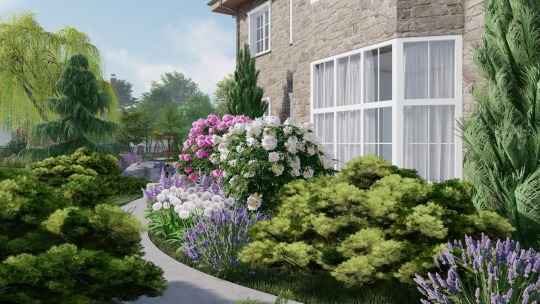




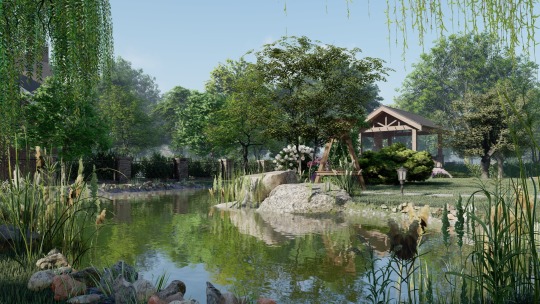
More images you can find by the link.
With love, Iri @owgrant8 and Nasti @lunarglitter13 💕
#good omens#neil gaiman#terry pratchett#david tennant#michael sheen#aziraphale#crowley#aziracrow#innefable husbands#the south downs cottage
40 notes
·
View notes
Text
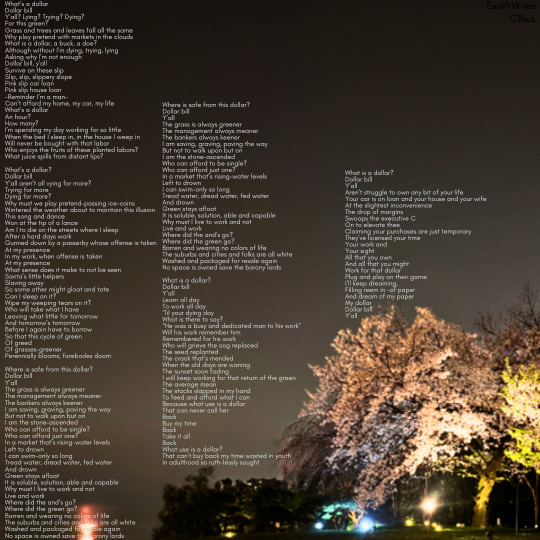
NaPoWriMo Vol. 3, 4.5.24
“That Ain't Playing Phaoroh at the American Dream“
What’s a dollar
Dollar bill
Y’all? Lying? Trying? Dying?
For this green?
Grass and trees and leaves fall all the same
Why play pretend with markets in the clouds
What is a dollar, a buck, a doe?
Although without I’m dying, trying, lying
Asking why I’m not enough
Dollar bill, y’all
Survive on these slip
Slip, slip, slippery slope
Pink slip car loan
Pink slip house loan
–Reminder I’m a man–
Can’t afford my home, my car, my life
What’s a dollar
An hour?
How many?
I’m spending my day working for so little
When the bed I sleep in, in the house I weep in
Will never be bought with that labor
Who enjoys the fruits of these planted labors?
What juice spills from distant lips?
What’s a dollar?
Dollar bill
Y’all aren’t all vying for more?
Trying for more
Dying for more?
Why must we play pretend–passing ice-coins
Wintered the weather about to maintain this illusion
This song and dance
Won at the tip of a lance
Am I to die on the streets where I sleep
After a hard days work
Gunned down by a passerby whose offense is taken
At my presence
In my work, when offense is taken
At my presence
What sense does it make to not be seen
Santa’s little helpers
Slaving away
So some other might gloat and tote
Can I sleep on it?
Wipe my weeping tears on it?
Who will take what I have
Leaving what little for tomorrow
And tomorrow’s tomorrow
Before I again have to borrow
So that this cycle of green
Of greed
Of grasses–greener
Perennially blooms; forebodes doom
Where is safe from this dollar?
Dollar bill
Y’all
The grass is always greener
The management always meaner
The bankers always keener
I am saving, graving, paving the way
But not to walk upon but on
I am the stone–ascended
Who can afford to be single?
Who can afford just one?
In a market that’s rising–water levels
Left to drown
I can swim–only so long
Tread water, dread water, fed water
And drown
Green stays afloat
It is soluble, solution, able and capable
Why must I live to work and not
Live and work
Where did the and’s go?
Where did the green go?
Barren and wearing no colors of life
The suburbs and cities and folks are all white
Washed and packaged for resale again
No space is owned save the barony lords
What is a dollar?
Dollar bill
Y’all
Learn all day
To work all day
‘Til your dying day
What is there to say?
“He was a busy and dedicated man to his work”
Will his work remember him
Remembered for his work
Who will grieve the cog replaced
The seed replanted
The crack that’s mended
When the old days are waning
The sunset soon fading
I will keep working for that return of the green
The average mean
The stacks slapped in my hand
To feed and afford what I can
Because what use is a dollar
That can never call her
Back
Buy my time
Back
Take it all
Back
What use is a dollar?
That can’t buy back my time wasted in youth
In adulthood so ruth-lessly sought
What is a dollar?
Dollar bill
Y’all
Aren’t struggle to own any bit of your life
Your car is on loan and your house and your wife
At the slightest inconvenience
The drop of margins
Swoops the executive C
On to elevate thee
Claiming your purchases are just temporary
They’ve licensed your time
Your work and
Your sight
All that you own
And all that you might
Work for that dollar
Plug and play on their game
I’ll keep dreaming,
Filling reem in -of paper
And dream of my paper
My dollar
Dollar bill
Y’all
@env0writes C.Buck
Ko-Fi & Venmo: @Zenv0
Support Your Local Artists!
Photo by my friend Mika
#writeblrcafe#poeticstories#capitalism#horrors of capitalism#american gothic#american dream#spoken word#slam poetry#rhythm and poetry#dollar dollar bill yall#napowrimo#napowrimo vol. 3#april#env0 writes#long poem#LONG poem#poetselixir#poetswhisper#midwest gothic#suburban gothic#retail gothic#retail hell#corporate america#corporation#America#usa#twcpoetry#poetryportal
13 notes
·
View notes
Text
every five seconds it's just like. Hey bad news. Accidentally planted the lemongrass with the perennial grasses don't worry we caught it and are replanting it in 5" pots. Uh oh but there was a misunderstanding and all the karl foerster grass got down in 5" pots too and pricer incorrectly. And uh oh, they actually got shuffled around and mistagged so some lemongrass is tagged as karl foerster and vise versa. The good news is, on smells like lemons so you gotta squat on the floor crushing every single plant trying to guess whether its a lemon grass or not or if you've now just got lemon residue on your hands
54 notes
·
View notes
Text
Mark Wootton and his wife, Eve Kantor, were the carbon-neutral pioneers of Australia’s red meat industry.
Years before the Paris agreement to keep global heating below 1.5C, and a decade before the Australian government committed to reaching net zero emissions, their family farm in south-western Victoria was declared carbon-neutral.
“In the early 2010s we were pretty cocky that we had conquered this thing,” Wootton says. “We thought we’d cracked the formula.”
Jigsaw Farms, a mosaic of lush pastures, eucalypt plantations, wildlife corridors and wetlands about 250km west of Melbourne, near the town of Hamilton, was the envy of the industry. It was lionised by the media, a favoured photo opportunity by politicians and held up by the red meat sector as a vision of the future.
The farm’s carbon-rich soils, 20% of which were forested, sequestered enough CO2 to offset its annual emissions from wool, lamb and beef production.
Or at least it did. The latest report tracking Jigsaw’s emissions, which is now undergoing peer review, confirmed that since about 2017 – the same year the industry body Meat and Livestock Australia (MLA) announced a target of net zero emissions by 2030 – Jigsaw Farms has been emitting more greenhouse gases than it could sequester.
“Cows and sheep are still there producing the same amount of methane [every year], but the trees grow up and carbon sequestration slows down,” says the report author, Prof Richard Eckard.
Eckard is an agricultural economist and the director of the school of agriculture, food and ecosystem sciences at the University of Melbourne. He became involved in measuring Jigsaw’s emissions a decade ago.
The 3,378-hectare farm spans six titles, bought by Wootton and Kantor between 1996 and 2003. Hardwood timber plantations cover 295 hectares, 24 hectares is remnant forest and a further 268 hectares are set aside for biodiversity. It hosts a fine wool merino operation with about 20,000 ewes, and 550 head of cattle.
Initially, the hundreds and thousands of trees they planted, combined with a switch to perennial grasses, significantly increased the amount of carbon sequestered on the property.
But those trees have now matured and passed peak sequestration, meaning they absorb less C02 year-on-year, and the soil is so carbon rich it can’t sequester any additional C02 from the atmosphere.
“Ten years later it all slows down because carbon saturation,” Eckard says. “It’s just the law of diminishing returns.”
The latest Jigsaw study estimated that in 2021, the farm sequestered 70.3% to 83.2% of its annual emissions. By 2031, as the farm’s forests grow older, models predict it will absorb just over half of what it did when carbon sequestration peaked in 2012.
The dilemma Jigsaw now faces reflects the broader challenge of decarbonising Australia’s red meat industry, Eckard says.
The industry claims it has reduced its emissions by 65% compared with 2005 levels, but this reduction relies on recorded decreases in deforestation and increases in forest regrowth, which some analysis suggests is overstated.
“Carbon sequestration through forestry is a short-term buy out of trouble,” Eckard says. “You can plant your way out of trouble and, like Jigsaw, get seven years of net zero, but ultimately, unless you do something about the methane, you’re not going to stay net zero.”
Climate neutrality v the ‘seaweed solution’
Other efforts to reduce the industry’s carbon footprint have focused on attempting to reduce the amount of methane expelled from the rumen, which accounts for 80% of the sector’s emissions. MLA has put more than $180m towards the problem, with no solution forthcoming. The results from the longest running commercial trial of a seaweed cow-feed, which aimed to cut methane by more than 80%, were lacklustre.
Selective breeding and dietary changes can help, says Eckard, but it’s slow going.
“It took the animal 50m years to evolve to produce meat and eat grass the way it does,” he says. “That can’t be overcome in three-year funding rounds.”
But he says that if producers adopt current best practices that will reduce their emissions intensity per kilogram of meat produced while research finds the “seaweed solution”.
On Jigsaw Farms, high reproductive rates, fast-growing livestock due to genetic selection and ample feed, and grazing stock at double the density of other farms in the district helps reduce the emissions that go into producing each animal.
“If that lamb or calf grows faster, so it gets to market quicker, so it grows faster, so, to be brutal, it can die and be eaten – your carbon intensity is dropping,” Wootton says.
This allows Jigsaw to sell its wool, lamb and beef at a premium in a market that is increasingly looking for farmers who can demonstrate strong environmental credentials.
This is particularly important for the export-focused Australian market, Eckard says. Seventy per cent of Australian-grown beef is sold into global supply chains ruled by international corporations, all of whom have net zero targets.
That’s the impetus behind the MLA’s “world leading” net zero target. This month Guardian Australia reported that the industry body described the target as “aligning the industry” towards improvement and said it did not need to be met, though it remains committed to the goal. Environmental scientists say reporting on the goal is based on unreliable land clearing data.
David Jochinke, the president of the National Farmers Federation, says the target is about the “aspiration” towards decarbonisation.
“We’ve always said at the NFF, we’re not going to reduce production in an attempt to get to net zero,” he says. “Will we make it? I’m not really sure, but we are going to give it a red hot go.”
A 2023 CSIRO report found the industry would fall short of the net zero goal and recommended a “climate-neutral” target be adopted instead, which would theoretically be achieved by reaching a point where the sector no longer causes any additional warming to the planet.
Australia’s peak cattle body, Cattle Australia, has also called for a shift to climate neutrality. But both Eckard and Wootton say the industry shouldn’t change course.
“I fear that if the industry fiddled with the metric what they would be effectively saying is ‘methane is no longer an issue so we don’t have to worry about it’,” Eckard says.
The director of the Australian National University Institute for Climate, Energy and Disaster Solutions, Mark Howden, says that unachievable or “false [climate] targets” are ineffective and can alienate both industries and the public.
He says the red meat sector’s goal is “in a sense the wrong target”. “We do need to go net zero in terms of C02, but in the case of methane we need to reduce it by about two-thirds in the long term to effectively meet the Paris agreement,” he says.
Wootton says the benefits of their regenerative approach to farming persist even if the farm’s carbon accounts are now in the red.
They did not initially set out to be carbon-neutral. The timber plantations were established on Jigsaw Farms to offer an alternative source of income. They planted permanent native vegetation to encourage biodiversity and shelter belts to protect livestock, and dug deep dams so they would always have a secure water supply.
A bird survey in 1996 found 46 bird species on the land. Today, there are 174. The land is healthier – that is, ironically, why carbon sequestration has stabilised.
“People come to us and go, shit, if they can’t go carbon-neutral, what does that mean for us,” Wootton says.
“It means you’ll have to do some of what we’ve done, do things differently from what we’ve done, and do some other things that we don’t even know we can do yet.
“There’s no silver bullet here, but there’s some silver buckshot, hopefully.”
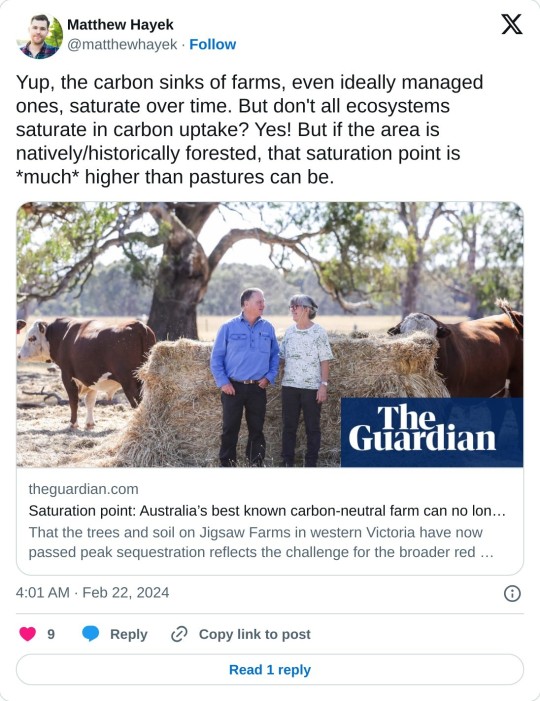

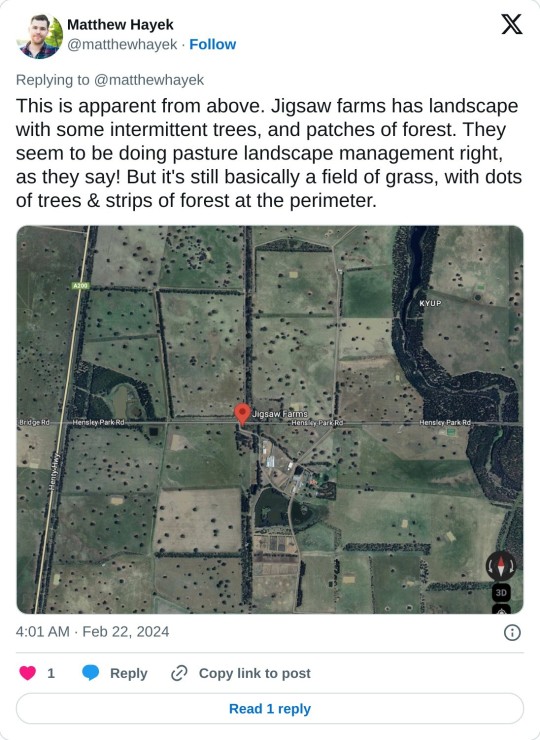




10 notes
·
View notes
Text


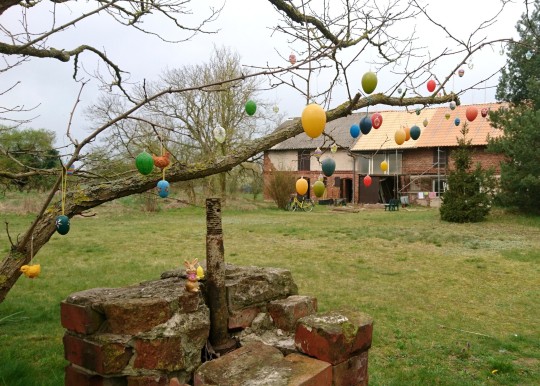


We sat around and watched. We planted willows and started a dead wood pile. We put old potatoes in the lawn to see if it becomes a vegetable garden. We put up the previous owners' easter decoration. We took parts of perennials from the big garden and moved them to the new bar's yard. I heavily pruned the rose and am now eagerly waiting to see how it'll bloom. We will continue to watch where the sunny patches are and where the water goes to decide what to do where.
It's my first time landscaping a property that is mostly grass/herbs and a few shrubs and I am so excited.
8 notes
·
View notes
Text
Nandini - Karikalan World Tour
Aditha Karikalan tells Parthipendra Pallavan and chieftains that he wants to go to distant places and conquer them. Nandini tells Vanthiyathevan that she prefers wandering in the same places on a magic horse rather than even going to the heaven.
Nandini: No. I don’t wish to go to Heaven. There’s a desert in the Pandya country with a few barren rocks in the middle of it, where not even grass or weeds grow. There are some caves there. At one time Digambara Jains stayed in them and performed penance, but now only snakes and jackals live there.
We don't know who told her about this particular desert. It could have been Alvarkadiyan too, but he says that he told her about Alvar stories, pasurams and Vaishnavite pilgrimage sites. Moreover, he hates Jains. The person who sends Vanthiyathevan to a place full of such jain rock caves (but not the same as the one Nandini said) is Aditha Karikalan himself.
Jains had made artificial caves around the temple and built catacombs in them. Digambara Jains used to sit in these manmade caves and perform penance. Later, the temple was renovated by the Chozha king and rebuilt in granite. However, the surrounding catacombs formed a wall around it. . . . Vandiyathevan met Eesana Siva Bhattar at the temple as Aditha Karikalar had told him to do. Bhattar told him to wait in the Jain catacomb.
Nandini: If I could get a flying horse, I would go to that desert and then fly to the island of Lanka. I believe there are high mountains in Lanka and dense forests which cover them. Herds of elephants roam around in the distant islands, the way herds of buffaloes wander around in the Chozha country. I want to see them all.
Karikalan: We shall then leave for Lanka and gather a huge army and leave for countries like Java, Srivijaya, Sumatra, Burma and Malaya.
All these were places with different species of Asian elephants, named Elephas maximus maximus, E. m. indicus (our Indian elephant), E. m.sumatranus.
Nandini: They say that from the beginning of time, there have been mountains perennially covered with snow at the centre of the world [Himalayas, specifically Mount Meru was considered "bhoo-madhya", the centre of the world]. They glisten like silver when the sun rises. I want to go on a flying horse to see those hilltops.
Karikalan: Parthibendran and I will meet at the estuary of Ganges River. Then we will join forces and go further north. One of my forbears, my namesake, Karikala Valavan, went up the Himalayas and hoisted the Tiger Flag in the one of the peaks the mountain range . . . With the help of my sword, with the help of my soldiers I’ll become the Emperor of the territory north of River Krishna.
Nandini: Further away there are deserts . . .filled with white sand that feels like burning fire by day. I want to go to all those places. Further away, the sea water freezes so hard because of the intense cold, that men and animals can walk over it. I want to go to all those places on my flying horse.
Karikalan: We shall hoist our Chozha flag in these places and then go to Arabia, Persia, Egypt and Rome.
We can see two important differences in their words that show their gender - class difference.
As Karikalan is a man and a prince, going to these places is just a matter of logistics for him. He wants to establish Chola supremacy in those places. For Nandini, it is possible only through magic. Even in her dreams, she can imagine accomplishing this only by traveling on a flying horse.
Karikalan just mentions the names and none of his listeners enquire about these places. They all are similarly educated and knowledgeable. But Nandini doesn't know many names, except Lanka. It is the long descriptions that she remembers.
It is obvious that someone told her about all these places. Who else could have been it? Perhaps he even promised to take her with him ☹️

I want to go there 👉🏻
#ponniyin selvan 2#ponniyin selvan#nandini#aditha karikalan#nandini x karikalan#nanditha#nandhini#nandini x aditha#aditya karikalan
30 notes
·
View notes
Text
Flowers of the March of Maedhros (possibly part one, there are so many!)
flora, fauna, geography and environment of Arda
I love doing general flora and fauna posts but I can’t fit everything in them so I’m trying to make more specific ones as well! please please feel free to send categories to work on with locations! Or any environmental world building asks!
extensive environmental world building for himring plus more in the Himring tag
Himring was the fortress of Maedhros in the March of Maedhros, a cold realm in Northeastern Beleriand located slightly Southeast of Dorthonion and south of Lothlann and Ard Galen. It was a cold region with taiga forested hills and icy waters, including the sources of several rivers, namely Celon and Little Gelion. The March was located between the cold mountains on the Southern and Eastern borders of Dorthonion and the mountainous regions of the Gap and Thargelion on its own Eastern border.
The cold likely comes from a combination of its proximity to the Ered Engrin and Ered Gorgoroth, especially given the boreal forested region of Dorthonion, as well as altitude in some parts of it. I go into this more on other posts.
The flora of the March is hardy, resistant to the cold that is present throughout so much of the year. Most flowers and herbaceous plants are herbaceous perennials that bloom in the spring and summer each year, sustained by their root stock despite the cold winters.
The March contains several habitats; boreal forests/taiga, montane steppes and meadows, riverbanks and marshier areas. Towards Maglor’s Gap, rocky outcrops including many of limestone invite plants that thrive on calcareous soils. Lothlann and Ard-galen were montane or boreal meadows. While boreal forest in many places is divided into three zones (closed forest where trees cover more than forty percent of the ground and have a dense layer of grass, high boreal or alpine and Southern boreal where croppings of temperate decidious trees might be found) I think the March and also Dorthonion which has some similarities in climate and ecology, would see a combination of these ecosystems.
Canon species: no canon species are associated with Himring, the March, or indeed much of F��anorian occupied Eastern Beleriand
I use what we can extrapolate as possibly indigenous based on descriptions of climate, looking at similar real world locations, etc. I am also always happy to write posts based on real world locations by suggestion! (I’ve done the Havens of Sirion based on Southwestern Australia for example, etc. I think Tol Himling would have a similar climate to Hokkaidō).
-Mountain and red clovers bloom on the hills and meadow steppes in the late spring and summer. Arctic dandelion grows in the meadows in the North towards Lothlann and Ard Galen as does Annual Gypsophila, cutleaf coneflower, arctic harebell (also grows on stream banks), broadleaf chives, cow parsnip, longstalk starwort, heath violet
-Mountain avens grow in rocky outcrops throughout the hills around Himring, usually in the summer. Moss campion also grows throughout the hills, above the tree line. Nodding campion, heath grounsel, snow saxifrage, baneberry (also stream banks)
-Great spur violet, fireweed (especially in clearings), snowdrop, wall lettuce, wild tulip and grow in the forested areas. Boreal forests often contain berries and the forested areas around the hills has many species including bog bilberry, black crowberry, cloudberry, and wild strawberry.
-Alongside the rivers grows wood or alpine sorrel alongside glacier buttercup, Lapland buttercup, Arctic butterbur, one flower fleabane (which also grows in forested belts and meadows), alpine rockcress, moor king, wood ruff, alpine butterwort, and arctic or prickly rose.
-Arctic and common meadow rue grows in the North and West of the March in boggier areas as does milky whitlow grass, a flowering plant.
-Common Groundsel grows throughout the region
World building notes:
-A number of these species have medicinal uses
-Others are used as fodder, in salads, garnishes and other dishes or in teas
-storing and preserving plants of various kinds is highly utilized in the March, more so than other elven realms. Both flora with medicinal and culinary uses are frequently preserved through drying, fermentation or other methods
34 notes
·
View notes
Text
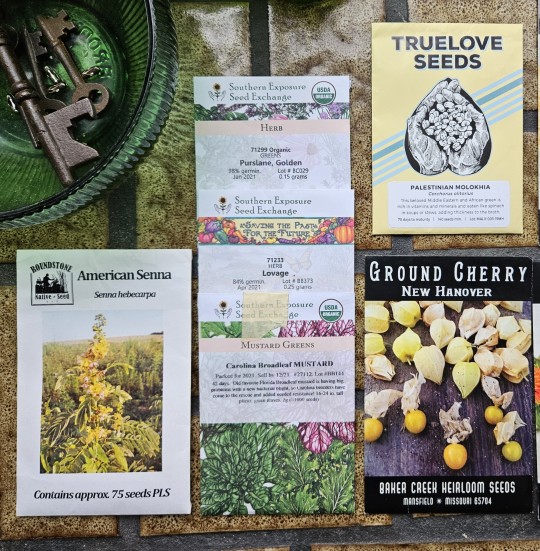
after years of gardening I have learned that I hate starting shit from seed indoors, I'm too scatterbrained and also we don't have a very good setup for it. I can't resist buying seed packets tho so I am just going to limit myself to five things this year.
Senna up by the peach tree, to have something dramatic and showy at the top of the hill
Everything else will go in the terraced beds. The purslane and ground cherries will self seed and the lovage is perennial, so that's less work next year. And the terraces are isolated from the rest of the yard by a strip of concrete so the self-seeding plants can't go ape shit and take over.
I will probably save seeds from the molokhia -- I'm told it likes this climate and I'm excited to try growing it. Not the mustard tho every attempt at cole crops has been a flop on this property.
The soil in the terraces should be in good shape this year. Last spring I put in composted horse and sheep manure and a thick layer of mulch. Nothing planted in them now but shallots, sage, and some monarda and sweet grass; the fucking groundhog ate everything else. Including my alpine strawberries wtf. The hardscaped borders of the terraces tho....lol. I need to replace one stone border with a wattle fence and build it up with more soil before planting.
Also here's my seed box, which I woodburned

3 notes
·
View notes
Text
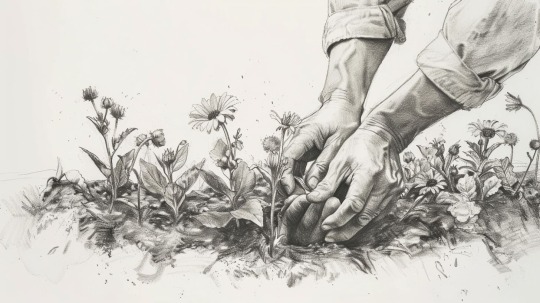
In a world stripped bare but for the raw earth and the stubborn sprouts of life that emerge from it, a pair of hands—worn yet gentle—nurture the nascent blooms with the sincerity of a silent prayer. They are the hands of someone who understands the weight of tending to things that grow, the critical balance of care and restraint. There is a sense of the ephemeral contrasted by the enduring, as flowers, simple and unassuming, reach for a sun they trust implicitly to return.
The soil under the nails, the creases in the knuckles, and the rolled-up sleeves speak of a quiet dedication not often sung but always felt. There’s no room for pretense here, at the junction of human touch and nature's embrace. Each flower, each blade of grass, is a testament to the tender conflict between survival and beauty.
This image, sketched in earnest strokes and shaded with an affection that can only be captured by hand, reminds us of a truth easily overlooked—the most delicate things often require the strongest of wills to flourish. Here, in this dance of fingers and flora, we are witness to the purest form of hope: a belief in life that persists, a conviction in the growth that comes with every day granted under the sky.
The picture, motionless yet full of potential, is a solitary moment of connection between mankind and the silent, perennial march of the natural world. It’s a whisper in the clamor of existence, saying, "Here, amidst all this, we are capable of softness."
#black and white#pencil drawing#hands#flowers#nurturing#growth#art#patience#life#earth#connection#hope#simplicity#elegance#human touch#nature
5 notes
·
View notes
Photo
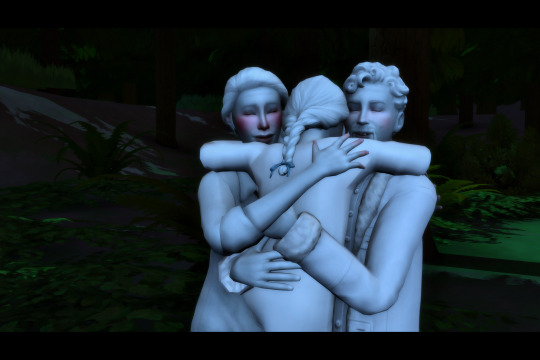

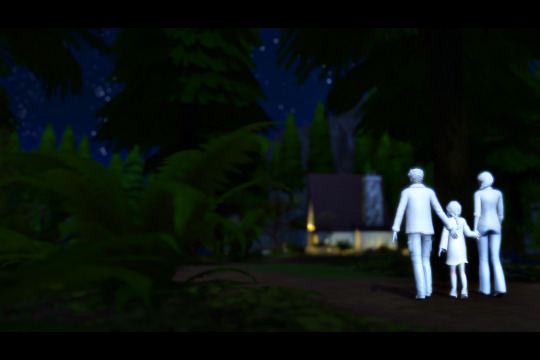

“Ambrosia?” A deep voice called out. The girl recognised it immediately.
“Father!”
“She’s over here Peri!”
“Oh my goodness, my Darling, are you alright?!” Perennial reunited with her daughter and embraced her.
“Yes, I think so. What are you wearing?” Amy giggled. Her mother was wearing clothes like she’d never seen before. “Why did you change your clothes?”
“We need to find some shelter”. Everlast suggested. “Come. This way”.
The trio fumbled their way through the forest, relying on Everlast’s knowledge to escape the leafy labyrinth. They eventually found themselves walking through fewer and fewer trees until they spied patches of open grass, small shrubs and flowers ahead of them. A building came into view; a house.
#ts4 story#ts4 legacy#berry pastel rainbowcy#bpr#berry sweet sims#fitgof bpr#fitgof chapter 4#fitgof gen 1
7 notes
·
View notes
Text
Parts of Nevada are being overrun by an explosion of flightless, ground-dwelling cannibalistic insects creating nightmares of Biblical proportions.
Business and residents said they are battling millions of Mormon crickets that descended on the state this week in an effort save land and morale.
In Elko, a city in northeastern Nevada south of the Idaho border, crickets converged Monday, covering roads, vegetation, and even local hospital walls, multiple media outlets are reporting.
“Just to get patients into the hospital we had people out there with leaf blowers, with brooms, at one point we even had a tractor with a snowplow on it just to push the piles of crickets and move them on their way,” Steve Burrows, director of community relations at Northeastern Nevada Regional Hospital, told local KSL TV.
Native to western North America, the crickets' populations are cyclic over many years and some residents in the mini-metropolis of just over 20,000 people, are not pleased with their return.
“They’re just gross,” Precious Drake of Elko, told the outlet. “They look like spiders, and they poop everywhere.”
What do Mormon Crickets eat?
According to the University of Nevada in Reno, Mormon crickets can grow larger than two inches and are found in rangelands west of the Missouri River and across all of Nevada. They eat perennials, grass, shrubs and crops, subsequently reducing feed for grazing wildlife and livestock.
Mormon crickets are also cannibalistic and, if their bellies are not full, will eat one another dead or alive.
The insects are not true crickets but are "shield-backed, short-winged katydids that resemble fat grasshoppers that cannot fly," according to the university. Adult Mormon crickets have long antennae and a shiny exoskeleton in a wide array of colors and patterns.
In mass quantities, their feeding contributes to soil erosion, poor water quality, nutrient depleted soils and other land damage.
Mormon crickets prefer drought conditions and can cause "substantial economic losses to rangeland, cropland, and home gardens," according to the university. "This is particularly true as adults and nymphs of Mormon crickets migrate in a band, eating plants along their paths."
The Nevada Department of Agriculture did not immediately respond to USA TODAY Friday morning to say how many counties reported an infestation.
Buggers' name stems from Utah
Last June, farmers and government officials across Nevada northeast to Montana battled the insects as they destroyed crops.
The insect's name dates back to the 1800s, when the bugs ruined the fields of Mormon settlers in Utah. But amidst drought and warming temperatures – conditions favored by the insects – outbreaks across the West have worsened.
According to Utah State University, an infestation is when there are at least eight crickets per square yard of land.
Because Utah's spring has been cool and wet, only "a few small infestations" have been reported so far this year, according to Utah Public Radio.
'Greasy with the squashed entrails'
In 2017, Arlington, Oregon, saw its largest Mormon cricket outbreak since the 1940s. The roads were "greasy with the squashed entrails of the huge insects," which damaged nearby wheat crops, the Associated Press reported.
Skye Krebs, a local rancher there, called outbreak "truly biblical."
"On the highways, once you get them killed, then the rest of them come," Krebs said.
Farmers who experience infestation issues are encouraged to call the their state's respective Department of Agriculture.
#nunyas news#they changed the name of the asian carp#because of fee fees#wonder if they'll do this too
11 notes
·
View notes
Text
An American Witch’s Herbal: Hosta

Hosta spp.
Common Names: Hosta, Plantain Lilly, Giboshi, Funkia
Type: Herbaceous Perennial
Element
Astrological
Magical Uses
Botanical Family: Asparagaceae
Region of Origin: China, Japan, Korea and Eastern Russia
Hosta, after Nicolaus Thomas Host, who was considered to be an expert on grasses. The genus went through many name changes to get where it is today, though.
Growth and Care
Is there any garden plant quite as ubiquitous as the hosta? It’s a popular pick because of its extreme hardiness--even the most beginner of a gardener would be hard pressed to kill these. Sometimes even when you think they’re gone for good, they have a tendency to rise from the dead and surprise you. While not at all particular, they do have a preference for at least some shade and may flounder if left in hot soil and all-day sun. Planting them underneath trees can be a good way to fill space, provide them protective shade and shelter from storms and hail, if those are issues in your area.
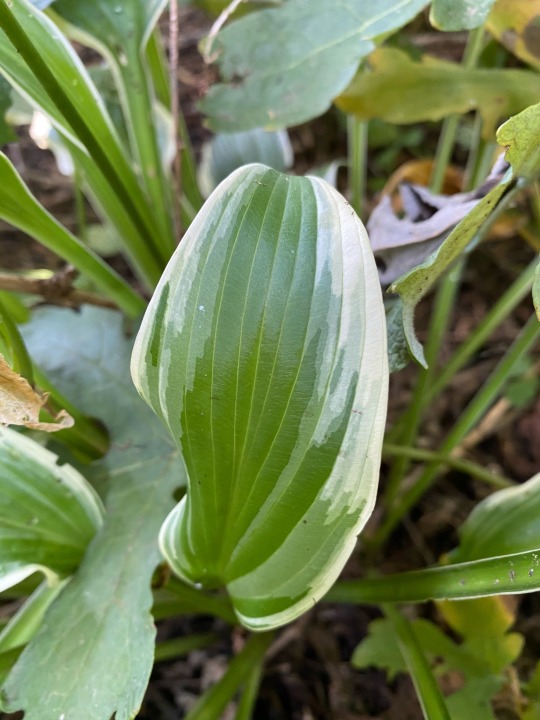
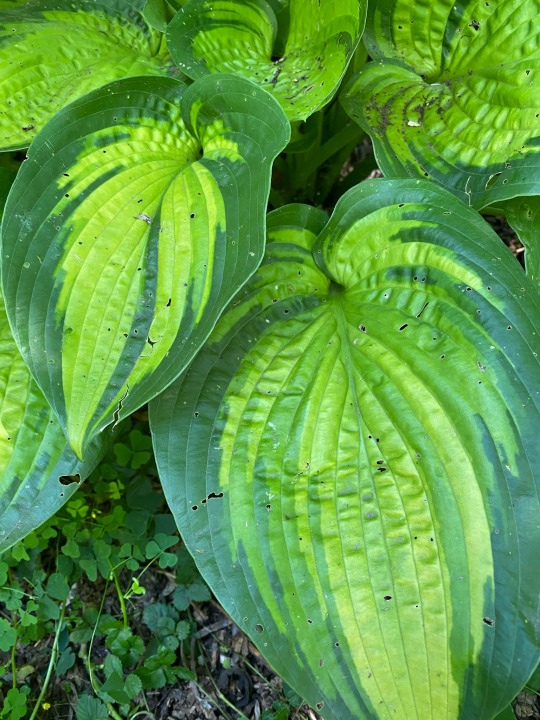
Mostly grown for attractive foliage that lasts from spring through summer, hostas come in a variety of colors and variations including white, yellow, all shades of green to almost blue, sometimes with stripes and splashes of multiple colors on the same plant. There are miniature varieties that comfortably live on office desks like the 4-5 inch ‘Mouse Ears,’ up to the massive ‘Empress Wu’ cultivar, which grows to a mature height of 4 feet tall and 6 feet wide. They put up a flower in summer, usually white or light purple in color, which rarely has much of a fragrance. The exception to this is H. plantaginea and its cultivars, sometimes called ‘August Lily.’
They will spread over time, and you may find yourself having to divide them every three years or so if you want to maintain your planting to roughly its original size.
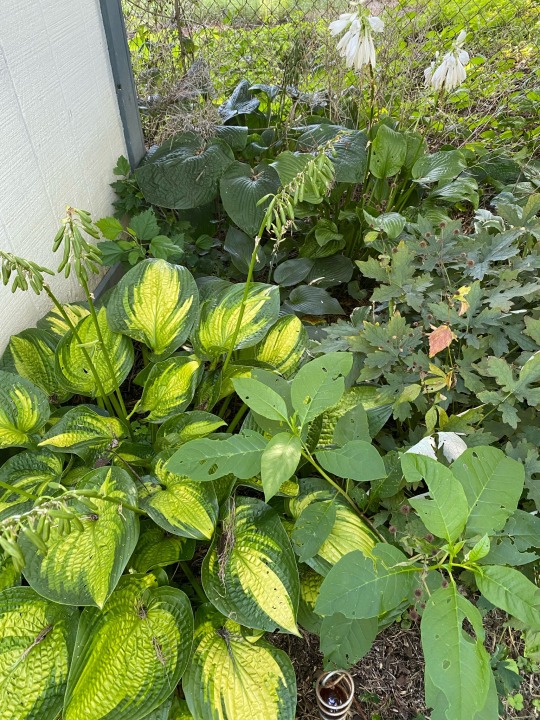
General Use
Though here in the west we tend to think of hostas as simply ornamental, in some parts of Asia it is grown as a vegetable. Deer, rabbits, slugs and snails will all happily munch on it, but it is toxic to dogs, cats and horses. Best way I’ve found to prepare them so far is to gather the young, still-furled shoots in spring and prepare them as you would asparagus, maybe by sautéing in a little butter or olive oil. The flavor is similar! (@alexisnikole TikTok/@blackforager on Insta has a great little video where she wraps them in [vegan] bacon!) Once the leaves have opened up, they do take a bitter turn.
Magical and Symbolic Use
In the language of flowers, the hosta has been used to symbolize devotion. This devotion doesn't really have a specifically romantic bent, as "friendship" is usually another meaning ascribed to these plants. Regardless of the specific connotation, the constancy and resilience of hostas make these an obvious choice for inclusion in rituals designed around growing and maintaining positive relationships.

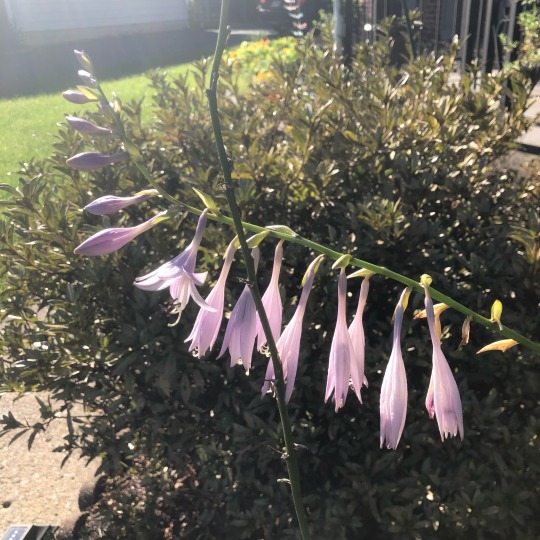
If you like this post and want to see more like it, check out the tag I use for this whole series throughout my blog: #american witch's herbal
#witch#witchcraft#green witch#green witchcraft#garden magic#grimoire#book of shadows#herbalism#american witch's herbal
7 notes
·
View notes